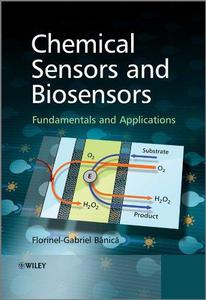
Chemical Sensors and Biosensors: Fundamentals and Applications By Florinel?Gabriel Banica(auth.)
2012 | 569 Pages | ISBN: 0470710667 | PDF | 15 MB
This is a modern introductory book on sensors, combining underlying theory with bang up to date topics such as nanotechnology. The text is suitable for graduate students and research scientists with little background in analytical chemistry. It is user-friendly, with an accessible theoretical approach of the basic principles, and referencesfor further reading. Thebook covers up-to-date advances in the sensor field, e.g. nanotechnology, microfluidics,and quantum dots. It includes calculation exercises and solutions, and contains a guide to Laboratory Exercises essential for course instructors and for experimental projects. An accompanying website contains colour illustrations and Powerpoint slides.Content: Chapter 1 What are Chemical Sensors? (pages 1-20): Chapter 2 Protein Structure and Properties (pages 21-27): Chapter 3 Enzymes and Enzymatic Sensors (pages 28-49): Chapter 4 Mathematical Modeling of Enzymatic Sensors (pages 50-65): Chapter 5 Materials and Methods in Chemical?Sensor Manufacturing (pages 66-100): Chapter 6 Affinity?Based Recognition (pages 101-117): Chapter 7 Nucleic Acids in Chemical Sensors (pages 118-134): Chapter 8 Nanomaterial Applications in Chemical Sensors (pages 135-156): Chapter 9 Thermochemical Sensors (pages 157-164): Chapter 10 Potentiometric Sensors (pages 165-216): Chapter 11 Chemical Sensors Based on Semiconductor Electronic Devices (pages 217-245): Chapter 12 Resistive Gas Sensors (Chemiresistors) (pages 246-257): Chapter 13 Dynamic Electrochemistry Transduction Methods (pages 258-313): Chapter 14 Amperometric Enzyme Sensors (pages 314-331): Chapter 15 Mathematical Modeling of Mediated Amperometric Enzyme Sensors (pages 332-346): Chapter 16 Electrochemical Affinity and Nucleic Acid Sensors (pages 347-366): Chapter 17 Electrical?Impedance?Based Sensors (pages 367-403): Chapter 18 Optical Sensors - Fundamentals (pages 404-434): Chapter 19 Optical Sensors - Applications (pages 435-453): Chapter 20 Nanomaterial Applications in Optical Transduction (pages 454-472): Chapter 21 Acoustic?Wave Sensors (pages 473-506): Chapter 22 Microcantilever Sensors (pages 507-517): Chapter 23 Chemical Sensors Based on Microorganisms, Living Cells and Tissues (pages 518-529):

Chemical Engineering in the Pharmaceutical Industry: R&D to Manufacturing By
2010 | 876 Pages | ISBN: 0470426691 | PDF | 74 MB
This book deals with various unique elements in the drug development process within chemical engineering science and pharmaceutical R&D. The book is intended to be used as a professional reference and potentially as a text book reference in pharmaceutical engineering and pharmaceutical sciences. Many of the experimental methods related to pharmaceutical process development are learned on the job. This book is intended to provide many of those important concepts that R&D Engineers and manufacturing Engineers should know and be familiar if they are going to be successful in the Pharmaceutical Industry. These include basic analytics for quantitation of reaction components- often skipped in ChE Reaction Engineering and kinetics books. In addition Chemical Engineering in the Pharmaceutical Industry introduces contemporary methods of data analysis for kinetic modeling and extends these concepts into Quality by Design strategies for regulatory filings. For the current professionals, in-silico process modeling tools that streamline experimental screening approaches is also new and presented here. Continuous flow processing, although mainstream for ChE, is unique in this context given the range of scales and the complex economics associated with transforming existing batch-plant capacity. The book will be split into four distinct yet related parts. These parts will address the fundamentals of analytical techniques for engineers, thermodynamic modeling, and finally provides an appendix with common engineering tools and examples of their applications.Content: Chapter 1 Chemical Engineering in the Pharmaceutical Industry: An Introduction (pages 1-20): David J. am EndeChapter 2 Current Challenges and Opportunities in the Pharmaceutical Industry (pages 21-27): Joseph L. Kukura and Michael Paul ThienChapter 3 Chemical Engineering Principles in Biologics: Unique Challenges and Applications (pages 29-55): Sourav Kundu, Vivek Bhatnagar, Naveen Pathak and Cenk UndeyChapter 4 Designing a Sustainable Pharmaceutical Industry: The Role of Chemical Engineers (pages 57-65): Concepcion Jimenez?Gonzalez, Celia S. Ponder, Robert E. Hannah and James R. HaganChapter 5 Scientific Opportunities through Quality by Design (pages 67-69): Timothy J. Watson and Roger NosalChapter 6 The Role of Chemical Engineering in Pharmaceutical API Process R&D (pages 71-78): Edward L. PaulChapter 7 Reaction Kinetics and Characterization (pages 79-99): Utpal K. Singh and Charles J. OrellaChapter 8 Understanding Rate Processes in Catalytic Hydrogenation Reactions (pages 101-111): Yongkui Sun and Carl LeblondChapter 9 Characterization and First Principles Prediction of API Reaction Systems (pages 113-136): Joe HannonChapter 10 Modeling, Optimization, and Applications of Kinetic Mechanisms with OpenChem (pages 137-153): John E. Tolsma, Brian Simpson, Taeshin Park and Jason MustakisChapter 11 Process Safety and Reaction Hazard Assessment (pages 155-182): Wim DermautChapter 12 Design of Distillation and Extraction Operations (pages 183-212): Eric M. CordiChapter 13 Crystallization Design and Scale?Up (pages 213-247): Robert Rahn McKeown, James T. Wertman and Philip C. Dell'OrcoChapter 14 Scale?Up of Mixing Processes: A Primer (pages 249-267): Francis X. McConville and Stephen B. KesslerChapter 15 Stirred Vessels: Computational Modeling of Multiphase Flows and Mixing (pages 269-297): Avinash R. Khopkar and Vivek V. RanadeChapter 16 Membrane Systems for Pharmaceutical Applications (pages 299-314): Dimitrios Zarkadas and Kamalesh K. SirkarChapter 17 Design of Filtration and Drying Operations (pages 315-345): Saravanababu Murugesan, Praveen K. Sharma and Jose E. TaboraChapter 18 The Design and Economics of Large?Scale Chromatographic Separations (pages 347-363): Firoz D. AntiaChapter 19 Milling Operations in the Pharmaceutical Industry (pages 365-378): Kevin D. Seibert, Paul C. Collins and Elizabeth FisherChapter 20 Process Scale?Up and Assessment (pages 379-405): Alan D. Braem, Jason T. Sweeney and Jean W. TomChapter 21 Scale?Up Dos and Don'ts (pages 407-416): Francis X. McConvilleChapter 22 Kilo Lab and Pilot Plant Manufacturing (pages 417-436): Jason C. Hamm, Melanie M. Miller, Thomas Ramsey, Richard L. Schild, Andrew Stewart and Jean W. TomChapter 23 Process Development and Case Studies of Continuous Reactor Systems for Production of API and Pharmaceutical Intermediates (pages 437-455): Thomas L. LaPorte, Chenchi Wang and G. Scott JonesChapter 24 Drug Solubility and Reaction Thermodynamics (pages 457-476): Karin Wichmann and Andreas KlamtChapter 25 Thermodynamics and Relative Solubility Prediction of Polymorphic Systems (pages 477-490): Yuriy A. Abramov and Klimentina PenchevaChapter 26 Toward a Rational Solvent Selection for Conformational Polymorph Screening (pages 491-504): Yuriy A. Abramov, Mark Zell and Joseph F. KrzyzaniakChapter 27 Molecular Thermodynamics for Pharmaceutical Process Modeling and Simulation (pages 505-519): Chau?Chyun ChenChapter 28 The Role of Simulation and Scheduling Tools in the Development and Manufacturing of Active Pharmaceutical Ingredients (pages 521-541): Demetri Petrides, Alexandros Koulouris, Charles Siletti, Jose O. Jimenez and Pericles T. LagonikosChapter 29 Quality by Design for Analytical Methods (pages 543-562): Timothy W. Graul, Kimber L. Barnett, Simon J. Bale, Imogen Gill and Melissa Hanna?BrownChapter 30 Analytical Chemistry for API Process Engineering (pages 563-579): Matthew L. JorgensenChapter 31 Quantitative Applications of NMR Spectroscopy (pages 581-596): Brian L. Marquez and R. Thomas WilliamsonChapter 32 Experimental Design for Pharmaceutical Development (pages 597-620): Gregory S. SteenoChapter 33 Multivariate Analysis for Pharmaceutical Development (pages 621-632): Frederick H. LongChapter 34 Process Modeling Techniques and Applications for Solid Oral Drug Products (pages 633-662): Mary T. am Ende, Rahul Bharadwaj, Salvador Garcia?Munoz, William Ketterhagen, Andrew Prpich and Pankaj DoshiChapter 35 Process Design and Development for Novel Pharmaceutical Dosage Forms (pages 663-672): Leah Appel, Joshua Shockey, Matthew Shaffer and Jennifer ChuChapter 36 Design of Solid Dosage Formulations (pages 673-702): Kevin J. Bittorf, Tapan Sanghvi and Jeffrey P. KatstraChapter 37 Controlled Release Technology and Design of Oral Controlled Release Dosage Forms (pages 703-726): Avinash G. Thombre, Mary T. am Ende and Xiao Yu(Shirley) WuChapter 38 Design and Scale?Up of Dry Granulation Processes (pages 727-755): Omar L. Sprockel and Howard J. StamatoChapter 39 Wet Granulation Processes (pages 757-780): Karen P. Hapgood and James D. LitsterChapter 40 Spray Atomization Modeling for Tablet Film Coating Processes (pages 781-799): Alberto Aliseda, Alfred Berchielli, Pankaj Doshi and Juan C. LasherasChapter 41 The Freeze?Drying Process: The Use of Mathematical Modeling in Process Design, Understanding, and Scale?Up (pages 801-817): Venkat Koganti, Sumit Luthra and Michael J. PikalChapter 42 Achieving a Hot Melt Extrusion Design Space for the Production of Solid Solutions (pages 819-836): Luke Schenck, Gregory M. Troup, Mike Lowinger, Li Li and Craig McKelveyChapter 43 Continuous Processing in Secondary Production (pages 837-851): Martin WarmanChapter 44 Pharmaceutical Manufacturing: The Role of Multivariate Analysis in Design Space, Control Strategy, Process Understanding, Troubleshooting, and Optimization (pages 853-878): Theodora Kourti
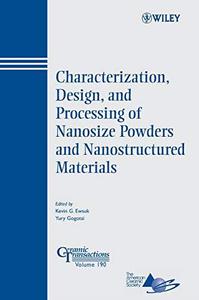
Characterization, Design, and Processing of Nanosize Powders and Nanostructured Materials: Ceramic Transactions Series, Volume 190 By
2006 | 226 Pages | ISBN: 0470080337 | PDF | 13 MB
Provides an organized and carefully selected collection of current research papers from two recent symposia, including The Characterization and Processing of Nanosize Powders and Particles and Nanoscale and Multifunctional Materials symposia both held at the 6th Pacific Rim Conference on Ceramic and Glass Technology in Fall 2005. The topics covered include techniques to characterize nanosize powders and nanoparticle dispersions, green processing of nanopowders, and the sintering and microstructure of nanoparticle assemblies.Content:
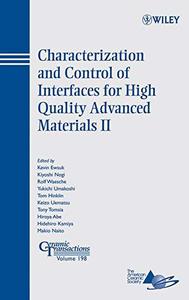
Characterization and Control of Interfaces for High Quality Advanced Materials II: Ceramic Transactions, Volume 198 By
2007 | 459 Pages | ISBN: 0470184140 | PDF | 45 MB
This volume includes papers from the Second International Conference on Characterization and Control of Interfaces for High Quality Advanced Materials, and Joining Technology for New Metallic Glasses and Inorganic Materials (ICCCI2006) in Kurashiki, Japan, 2006. Interfaces are critically important to a broad spectrum of materials and technologies. This Proceedings of ICCCI 2006 features 71 peer-reviewed papers on interface characterization and control technology for materials synthesis, powder processing, composite processing, joining, and to control airborne particulates.Content:
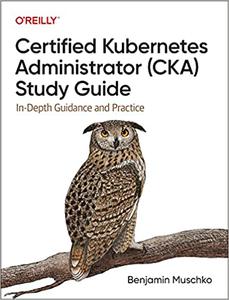
Certified Kubernetes Administrator (CKA) Study Guide: In-Depth Guidance and Practice
English | 2022 | ISBN: 1098107225 | 255 pages | True EPUB, MOBI | 6.77 MB
Shroff Publishers do not endorse the preview pages of kindle linked to our ISBNs. All Indian Reprints of O'Reilly are Printed in Grayscale
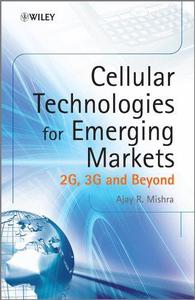
Cellular Technologies for Emerging Markets: 2G, 3G and Beyond By Ajay R. Mishra(auth.)
2010 | 317 Pages | ISBN: 0470779470 | PDF | 6 MB
In this book, the author addresses technologies that are being used in emerging cellular markets. These include GSM/EGPRS and CDMA which are being deployed at a rapid pace, while technologies such as UMTS (3G)/ HSPA (3.5G) which have started to find a place in these high growth markets, are also considered. The book examines other technologies including LTE (3.9G) which have already moved out of research labs into the commercial world. 2G-CDMA is widely used, while further developments, e.g. CDMA2000 are also finding acceptance in the commercial arena. IMS/Convergence is increasingly popular all over the world; UMA, which is deployed mostly in North America; and DVB which is gaining worldwide popularity, especially in South Asia, are all reviewed. Each chapter discusses a different technology and is structured into three parts. The technology is examined at an overview level, first explaining what the technology is and then considering the technical features of the technology. The chapter concludes by looking at the planning/implementation aspects of the technology. Key Features:Useful for all cellular industry professionals as provides an overview of the currently deployed technologies in mass scale, and the forthcoming technologies that are expected to make an impact in the future, such as 4th Generation Cellular Networks. One of the first books on the market to encompass all the major cellular technologies, as well as considering the design and implementation perspective. Wireless Technology will play a key role in uplifting the economies of the Emerging countries globally. Ashok Chandra, Wireless Advisor to Govt. of IndiaContent: Chapter 1 Cellular Technology in Emerging Markets (pages 1-14): Chapter 2 GSM and EGPRS (pages 15-53): Chapter 3 UMTS (pages 55-93): Chapter 4 CDMA (pages 95-124): Chapter 5 HSPA and LTE (pages 125-151): Chapter 6 OFDM and All?IP (pages 153-171): Chapter 7 Broadband Wireless Access: WLAN, Wi?Fi and WiMAX (pages 173-200): Chapter 8 Convergence and IP Multimedia Sub?System (pages 201-228): Chapter 9 Unlicensed Mobile Access (pages 229-244): Chapter 10 DVB?H (pages 245-263):
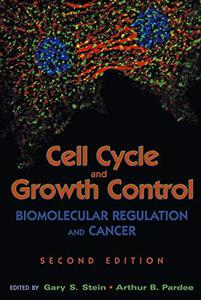
Cell Cycle and Growth Control: Biomolecular Regulation and Cancer, Second Edition By
2004 | 802 Pages | ISBN: 0471250716 | PDF | 20 MB
The groups of specialized cells that make up the various human tissues depend on an intricate communication network to regulate gene expression that in turn mediates growth, cell-type specific function, division, and programmed cell death. This network consists of extracellular signals interacting with the receptors of individual cells and determining the fate of each. Since this regulatory system plays a critical role in complex tissue, aberrations or malfunctions often accompany the onset and progression of cancer. Cell Cycle and Growth Control: Biomolecular Regulation and Cancer, Second Edition provides a solid basis for understanding cell cycle and growth control as it relates to biological regulation, with a special emphasis on examining these processes in the context of cancer. Newly updated with the latest significant advances, this Second Edition features: * Cutting-edge applications in clinical diagnostics and therapeutics * Focus on mechanisms mediating the control of proliferation * Numerous clear illustrations * Extensive bibliography * Well-recognized, expert chapter authors * Video clips on accompanying Web site showing cell cycle control Cell Cycle and Growth Control, Second Edition offers both an introduction to important concepts and detailed discussion of regulatory mechanisms at the cellular, biochemical, genetic, and molecular levels. The only book to comprehensively cover both the foundations and cutting-edge advances in understanding cell cycle and growth control, this text also contains an expert perspective on innovative strategies for cancer treatment, making it a vital companion for researcher and clinician alike.Content: Chapter 1 Cell Fates (pages 1-13): Arthur B. PardeeChapter 2 Architectural Organization of the Regulatory Machinery for Transcription, Replication, and Repair: Dynamic Temporal?Spatial Parameters of Cell Cycle Control (pages 15-92): Corey D. Braastad, Sayyed K. Zaidi, Martin Montecino, Jane B. Lian, Andre J. van Wijnen, Janet L. Stein and Gary S. SteinChapter 3 Cell Cycle Regulatory Cascades (pages 93-128): Heide L. Ford, Robert A. Sclafani and James DegregoriChapter 4 Membrane Receptors and Signal Transduction Pathways in G1: Regulation of Liver Regeneration and T Cell Proliferation (pages 129-147): Joseph F. Porter and David T. DenhardtChapter 5 Onset of Dna Synthesis and S Phase (pages 149-200): G. Prem?Veer Reddy, Eugenia Cifuentes, Uma Bai, Mani Menon and Evelyn R. BarrackChapter 6 The Progression and Regulation of Mitotic Events (pages 201-235): Greenfield Sluder, Edward H. Hinchcliffe and Conly L. RiederChapter 7 Cell Cycle Inhibitory Proteins (pages 237-264): Carmen Carneiro and Andrew KoffChapter 8 Chromatin Remodeling and Cancer (pages 265-295): Cynthia J. Guidi and Anthony N. ImbalzanoChapter 9 Extracellular Matrix: Tissue?specific Regulator of Cell Proliferation (pages 297-332): Aylin Rizki and Mina J. BissellChapter 10 Angiogenesis and Blood Supply (pages 333-367): Judah FolkmanChapter 11 Regulation of Cell Growth, Differentiation, and Death during Metamorphosis (pages 369-395): Hans Laufer and Eric H. BaehreckeChapter 12 Translational Control and the Cell Cycle (pages 397-448): Robert E. RhoadsChapter 13 Telomere Structure and Function Provides Insights into the Generation of Genomic Instability and Carcinogenesis (pages 449-465): Colleen Fordyce and Thea D. TlstyChapter 14 Immortalization by Sv40 Large T Antigen (pages 467-495): Rowena L. Lock, Silvia Benvenuti and Parmjit S. JatChapter 15 Apoptosis Signaling in Normal and Cancer Cells (pages 497-521): Shulin Wang and Wafik S. El?DeiryChapter 16 Mutagenesis, Mutations, and Dna Repair (pages 523-570): Roger D. JohnsonChapter 17 Oncogenes (pages 571-606): Stacey J. Baker and E. Premkumar ReddyChapter 18 Role of the Retinoblastoma Family in Cell Cycle Progression and Growth Control (pages 607-634): Valeria Masciullo and Antonio GiordanoChapter 19 p53 Tumor?Suppressor Genes (pages 635-666): Faith A. Zamamiri?Davis and Gerard P. ZambettiChapter 20 Cell Cycle and Growth Control: Current Clinical Applications (pages 667-703): Michael DeiningerChapter 21 Misregulated Fate-Cancer (pages 705-771): Arthur B. Pardee

Case Studies in Islamic Banking and Finance: Case Questions & Answers By Brian Kettell(auth.)
2011 | 181 Pages | ISBN: 0470978015 | PDF | 2 MB
Case Studies in Islamic Banking and Finance is a pioneering resource that provides practical insights into the real world of Islamic financial transactions, and illustrates the complexities of this rapidly growing mode of modern finance. Based around 12 individual cases, the book stimulates discussion and develops the reader's understanding of Islamic finance by contrasting the theoretical concepts discussed in the author's companion text Introduction to Islamic Banking and Finance with practical real world situations. The cases cover core Islamic banking and finance topics including the Ijara, Mudaraba and Musharaka contracts; Islamic mortgages for home finance; leverage; and issues involved in opening an Islamic bank. Financial statement analysis for Islamic banks, the implications for fund management for equity investing and the impact of loan defaults on Islamic and conventional banks are also included. Each chapter concludes with a set of questions designed to test the reader's understanding of each case, with suggested solutions at the end of the book. This book is a must have resource for those wishing to apply their understanding of this complex subject and is an essential read for anyone seeking practical examples of how to apply the concepts in a real world environment.Content: Chapter 1 Case Study 1: Ijara Contract (pages 1-11): Chapter 2 Case Study 2: Musharaka Contract (pages 13-18): Chapter 3 Case Study 3: Diminishing Musharaka Contract (pages 19-23): Chapter 4 Case Study 4: Mudaraba Contract (pages 25-32): Chapter 5 Case Study 5: Murabaha, Musharaka, Ijara and Ijara wa Iqtina Contracts (pages 33-36): Chapter 6 Case Study 6: Islamic Home Finance (pages 37-48): Chapter 7 Case Study 7: Sources of Finance for Islamic Banks (pages 49-54): Chapter 8 Case Study 8: Financial Statement Analysis for Islamic Banks (pages 55-77): Chapter 9 Case Study 9: Islamic Investment Prohibitions (pages 79-89): Chapter 10 Case Study 10: Opening an Islamic Bank within aWestern Regulatory Framework (pages 91-108): Chapter 11 Case Study 11: Leverage and Islamic Banking (pages 109-114): Chapter 12 Case Study 12: Impact of Non?performing Loans on Islamic and Conventional Banks (pages 115-117):

Cardiac Resynchronization Therapy, Second Edition By
2008 | 455 Pages | ISBN: 140517739X | PDF | 20 MB
Cardiac Resynchronization Therapy continues to evolve at a rapid pace. Growing clinical experience and additional clinical trials are resulting in changes in how patients are selected for CRT. This new edition of the successful Cardiac Resynchronization Therapy builds on the strengths of the first edition, providing basic knowledge as well as an up-to-date summary of new advances in CRT for heart failure. Fully updated to include information on technological advances, trouble shooting and recent key clinical trials, and with nine new chapters, this expanded text provides the latest information, keeping the reader up-to-date with this rapidly evolving field.The second edition of Cardiac Resynchronization Therapy is an essential addition to your collection.Content: Chapter 1 The Epidemiology of Heart Failure and Commonly Associated Conduction Disorders (pages 1-14): Maren E. Jeffery and Mariell JessupChapter 2 Comprehensive Pharmacologic Management Strategies for Heart Failure (pages 15-34): Garrie J. Haas and William T. AbrahamChapter 3 Electrical Activation Sequence (pages 35-54): Cecilia Fantoni and Angelo AuricchioChapter 4 Myocardial Mechano?Energetics (pages 55-76): Tammo Delhaas and Frits W. PrinzenChapter 5 Assessment of Electrical and Mechanical Dyssynchrony: Conventional Echocardiography (pages 77-90): Ole?A. BreithardtChapter 6 Newer Echocardiographic Techniques for the Assessment of Cardiac Resynchronization Therapy (pages 91-131): Cheuk?Man Yu and Qing ZhangChapter 7 Value of Non?Echocardiographic Imaging Techniques in Cardiac Resynchronization Therapy (pages 132-143): Claudia Ypenburg, Gabe B. Bleeker, Martin J. Schalij and Jeroen J. BaxChapter 8 Programming and Diagnostic Features of Cardiac Resynchronization Therapy Devices (pages 144-165): David Luria, Osnat Gurevitz and Michael GliksonChapter 9 Anatomy of the Coronary Sinus (pages 166-182): Samuel J. AsirvathamChapter 10 Techniques for Visualizing the Coronary Sinus and Coronary Venous Anatomy (pages 183-195): Jagmeet P. Singh and Angelo AuricchioChapter 11 Implantation Techniques for Cardiac Resynchronization Therapy (pages 196-238): Michael O. SweeneyChapter 12 Surgical Approaches to Epicardial Left Ventricular Lead Implantation for Biventricular Pacing (pages 239-249): Sandhya K. Balaram, Joseph J. DeRose and Jonathan S. SteinbergChapter 13 Remote Navigation Implantation Technique (pages 250-260): Carlo Pappone and Vincenzo SantinelliChapter 14 Clinical Trials Supporting Current Indications for CRT (pages 261-276): David L. Hayes and William T. AbrahamChapter 15 Trials of CRT in Atrial Fibrillation and Atrial Rhythm Management Issues (pages 277-289): Maurizio Gasparini and Francois RegoliChapter 16 Ongoing Trials to Further Shape the Future of CRT (pages 290-300): David L. Hayes and Cheuk?Man YuChapter 17 Consideration of CRT in the Pediatric Population (pages 301-308): Anne M. DubinChapter 18 Importance of the Surface Electrocardiogram for the Assessment of Cardiac Resynchronization (pages 309-323): S. Serge Barold, Michael C. Giudici and Bengt HerwegChapter 19 Troubleshooting (pages 324-355): Christophe Leclercq, Philippe Mabo and J. Claude DaubertChapter 20 Optimization of Cardiac Resynchronization Therapy (pages 356-373): Jeffrey Wing?Hong Fung, Stephane Garrigue and Cheuk?Man YuChapter 21 Management Strategies for Patients not Responding to CRT (pages 374-387): John P. BoehmerChapter 22 Device?Based Monitoring and Lung Impedance (pages 388-403): Jeffrey Wing?Hong Fung, Philip B. Adamson and Cheuk?Man YuChapter 23 Device?Based Patient Management (pages 404-418): Maria Rosa Costanzo and Salpy PamboukianChapter 24 Health Economics (pages 419-435): Francisco Leyva

Michael Horsley, "CRYPTOCURRENCY: The Complete Basics Guide For Beginners. Bitcoin, Ethereum, Litecoin and Altcoins, Trading and Investing, Mining, Secure and Storing, ICO and Future of Blockchain and Cryptocurrencies"
English | 2017 | ISBN: 1981309772 | ASIN: B077SP34ZK | EPUB | pages: 94 | 0.5 mb
Giveaway price 5.99 9.99 Only 2 days left


